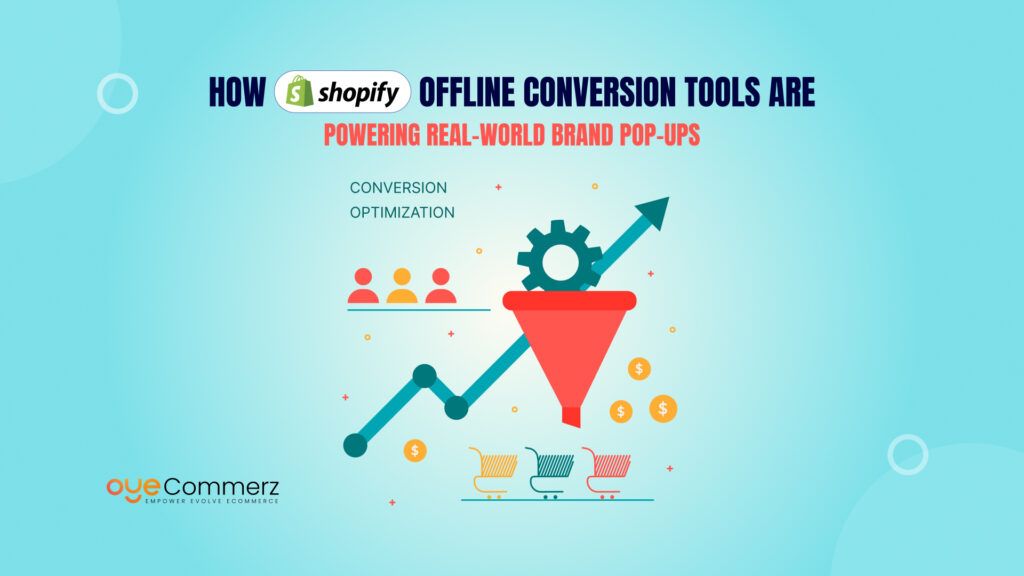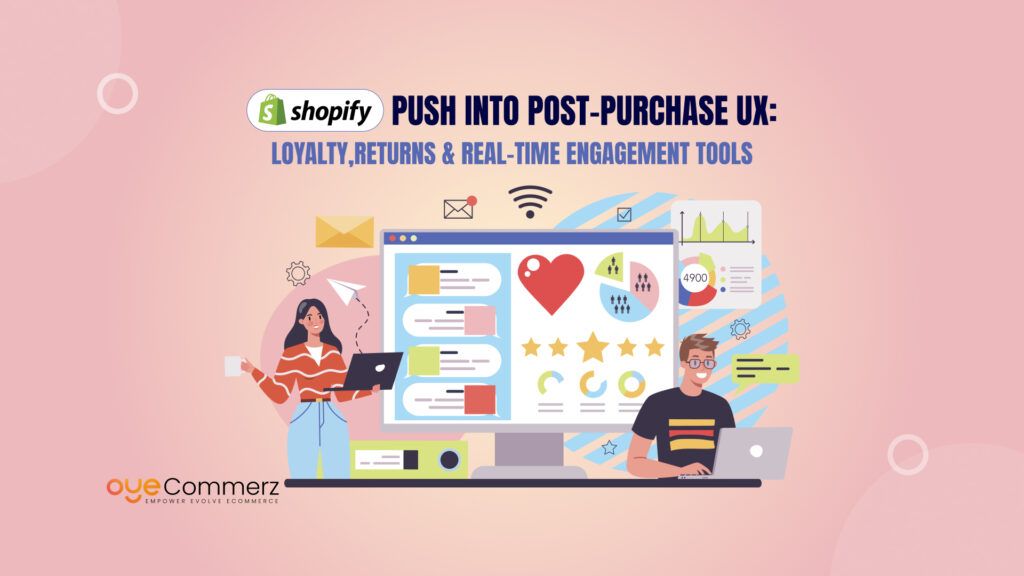eCommerce businesses lose up to 30% of revenue due to inefficient operations and that number grows as the business scales. Managing inventory, orders, and customer data separately leads to delays, errors, and missed growth opportunities.
ERP (Enterprise Resource Planning) systems solve this by centralizing business processes into one platform. And when integrated with Shopify, they create a seamless flow of data between your storefront and backend operations.
In this blog, we’ll break down the top benefits of Shopify ERP integration, why it matters, and how it can help your business scale smarter and faster.
Table of Contents
ToggleWhat is Shopify ERP Integration?
ERP (Enterprise Resource Planning) systems are software platforms that help businesses manage and automate core functions like inventory, order processing, accounting, HR, and customer relationship management all in one place. They’re essential for keeping operations efficient, especially as a business scales.
Shopify ERP integration connects your Shopify store with an ERP system, allowing data to flow automatically between your storefront and your back-office systems. This integration typically happens through APIs or middleware solutions that sync key information like:
- Product and inventory updates
- Orders and shipping status
- Customer data and invoices
- Financials and tax details
This ensures you’re always working with real-time, accurate data across all departments.
Popular ERPs that integrate with Shopify include:
- NetSuite – A robust solution for fast-growing and enterprise brands
- SAP – Ideal for large-scale and global operations
- Microsoft Dynamics 365 – Great for businesses needing flexibility and deep integrations
- Odoo – An open-source ERP with strong customization options
- QuickBooks Commerce – Suitable for small to medium-sized businesses
With the right ERP integration, your Shopify store becomes more than a sales channel it becomes part of a fully connected business system.
Why eCommerce Businesses Need ERP Integration
Running an eCommerce business isn’t just about selling products, it’s about managing a complex network of operations behind the scenes. As your business grows, so do the challenges.
Disconnected Systems Create Chaos
When inventory, orders, accounting, and customer data are managed across separate tools or spreadsheets, it leads to:
- Data silos
- Manual errors
- Delayed order fulfillment
- Inaccurate financial reports
This kind of fragmentation slows down decision-making and frustrates customers and teams alike.
Real-Time Data Is No Longer Optional
Today’s consumers expect fast service and up-to-date information. Without real-time visibility into stock levels, shipping status, or customer history, it’s easy to fall behind. ERP integration gives you a single source of truth helping you deliver accurate, timely service.
Scalability Requires Smart Systems
As sales channels multiply and order volumes grow, manual processes can’t keep up. ERP integration helps automate workflows and streamline operations so you can scale without increasing overhead or complexity.
In short, Shopify ERP integration isn’t just about efficiency it’s about preparing your business for sustainable growth.
Major Benefits of Shopify ERP Integration
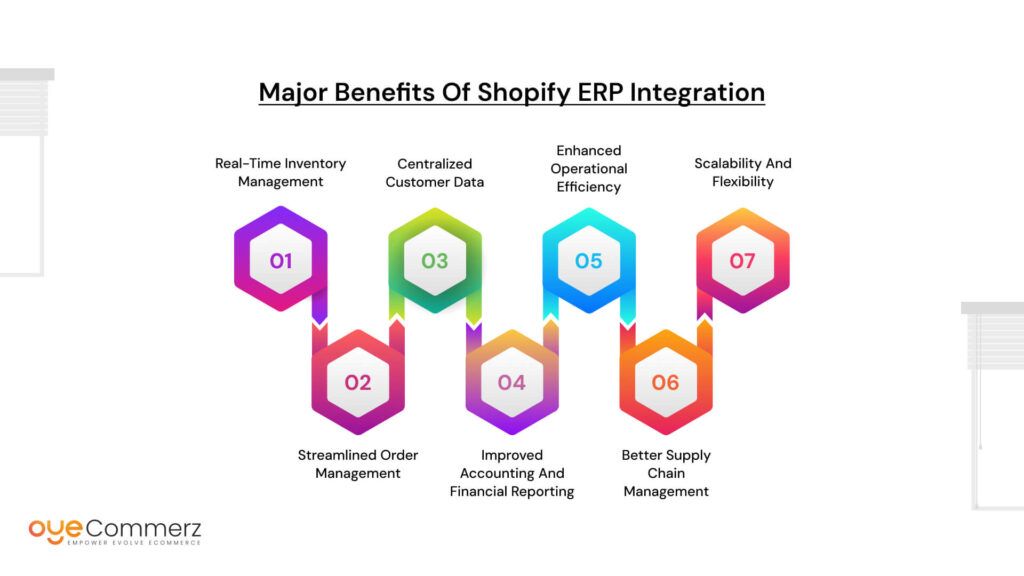
1. Real-Time Inventory Management
Managing inventory manually across multiple systems often leads to inconsistencies, delays, and lost sales. With Shopify ERP integration, your inventory is always up-to-date no matter where or when a sale happens.
- Seamless Syncing: Product availability automatically updates across Shopify and your ERP system, ensuring customers only see what’s actually in stock.
- Prevent Stockouts & Overstocking: Real-time visibility helps you maintain optimal stock levels, reducing the risks of missed sales or excess inventory sitting idle.
- Better Forecasting: Integrated sales and inventory data enables more accurate demand forecasting, so you can plan smarter and reduce carrying costs.
This level of visibility not only keeps your operations efficient but also builds trust with your customers by preventing out-of-stock surprises.
2. Streamlined Order Management
Order processing can quickly become a bottleneck when handled manually especially as sales increase. Shopify ERP integration removes this friction by automating the entire order flow.
- Auto-Sync of Orders: As soon as a customer places an order on Shopify, the details are instantly transferred to your ERP system for processing, without manual input.
- Faster Fulfillment: Integrated systems speed up picking, packing, and shipping by providing your fulfillment team with real-time order and inventory data.
- Fewer Errors, Happier Customers: By eliminating manual entry and delays, you reduce fulfillment mistakes and ensure timely deliveries leading to a more reliable and satisfying customer experience.
Ultimately, this automation helps your team handle higher order volumes with less effort and greater accuracy.
3. Centralized Customer Data
When customer information is scattered across platforms, it’s hard to deliver a consistent and personalized experience. Shopify ERP integration brings all your customer data into one place giving your team a complete view of each customer’s journey.
- Unified Customer Profiles: Track every interaction, order, return, and support ticket in a single, centralized system.
- Stronger CRM: With accurate, real-time data, your sales and support teams can engage more effectively, respond faster, and build long-term relationships.
- Smarter Marketing: Use detailed purchase histories and behavior insights to personalize offers, segment audiences, and launch more targeted campaigns.
By connecting Shopify with your ERP, you turn raw data into actionable insights that help you better understand, serve, and retain your customers.
4. Improved Accounting and Financial Reporting
Managing financials manually can be time-consuming and error-prone especially when pulling data from multiple systems. With Shopify ERP integration, your financial processes become faster, more accurate, and easier to manage.
- Automated Financial Workflows: Invoicing, tax calculations, and journal entries are handled automatically, reducing the need for manual input and ensuring compliance.
- Simplified Reconciliation: Sales data from Shopify flows directly into your ERP, making it easy to match transactions, reconcile accounts, and close books faster.
- Real-Time Insights: Access up-to-date financial reports and dashboards that give you a clear view of revenue, margins, and overall profitability whenever you need them.
This level of automation not only saves time but also gives your finance team the clarity they need to support smarter business decisions.
5. Enhanced Operational Efficiency
Manual processes slow down workflows, increase labor costs, and leave room for costly errors. Shopify ERP integration eliminates these inefficiencies by automating routine operations across departments.
- No More Manual Data Entry: Information like orders, inventory levels, and customer details sync automatically between Shopify and your ERP.
- Task Automation: Repetitive processes such as generating shipping updates, creating purchase orders, or updating stock run in the background with minimal human input.
- Lower Costs, Fewer Errors: With fewer hands involved, you reduce the risk of mistakes while freeing up your team to focus on strategic work instead of admin tasks.
This streamlined approach creates a leaner, more agile operation that can respond quickly to customer demands and market changes.
6. Better Supply Chain Management
A strong supply chain is essential for timely fulfillment and customer satisfaction. Shopify ERP integration brings clarity and control to every step from procurement to delivery.
- Real-Time Coordination: Sync inventory levels and order statuses with suppliers and warehouses to ensure everyone is working from the same data.
- Smart Replenishment Alerts: Set automated triggers to reorder stock when it hits predefined thresholds, preventing stock outs without over-ordering.
- Faster Delivery Timelines: With improved visibility and communication across your supply chain, you can process orders faster and deliver them on time, every time.
By integrating your ERP with Shopify, your supply chain becomes more predictable, responsive, and efficient even as demand grows.
7. Scalability and Flexibility
As your business grows, so do your operational needs. Shopify ERP integration gives you the foundation to scale without friction and adapt to change with ease.
- Multi-Channel Ready: Seamlessly expand to new sales channels like Amazon, eBay, or in-store retail all managed from a centralized ERP system.
- Adaptable to Change: Whether you’re introducing new product lines, updating fulfillment strategies, or shifting to a new market, ERP integration allows your systems to evolve with your business.
- Custom Workflows & Reports: Tailor automations, approval processes, and reports to match your unique business model and decision-making needs.
With this flexibility, your operations remain agile and future-ready no matter how your business model or market conditions shift.
Shopify ERP Integration Use Cases
Shopify ERP integration isn’t just a tech upgrade it’s a game-changer for businesses across different models and scales. Here are some real-world use cases that highlight its impact:
B2B & Wholesale Businesses
Wholesale brands often deal with large order volumes, complex pricing structures, and multiple customer tiers. ERP integration helps:
- Manage bulk orders and custom pricing efficiently
- Automate invoicing and credit terms
- Sync customer-specific catalogs and inventory levels
Example: A B2B electronics supplier integrated Microsoft Dynamics with Shopify Plus and reduced order processing time by 60%.
DTC Brands Focused on Fulfillment & Support
Direct-to-consumer brands need to offer fast, seamless experiences across the buyer journey. ERP integration helps:
- Streamline order fulfillment and reduce shipping delays
- Improve support response through centralized customer data
- Personalize marketing and retention efforts with integrated insights
Example: A skincare brand improved fulfillment speed by 40% and reduced return-related issues after integrating NetSuite with Shopify.
Global Brands Managing Complexity
International operations come with unique challenges: multiple currencies, tax rules, and stock locations. ERP integration helps:
- Maintain real-time visibility across multiple warehouses
- Automate multi-currency accounting and local tax compliance
- Coordinate inventory and orders across regions
Example: A fashion brand operating in North America and Europe used SAP ERP to centralize inventory and cut down delivery time discrepancies across regions.
Choosing the Right ERP for Your Shopify Store
Not all ERP systems are created equal and choosing the right one depends on your business’s unique needs. Before integrating, it’s important to evaluate your current operations, growth plans, and technical requirements.
Key Factors to Consider
- Business Size: Larger operations need more advanced capabilities and scalability.
- Industry Needs: Manufacturing, wholesale, retail, and services all have different ERP priorities.
- Budget: Costs vary widely between ERP systems from open-source options to enterprise-grade platforms.
- Integration Complexity: Some ERPs offer native Shopify integrations, while others require third-party middleware or custom APIs.
Top ERP Systems Compatible with Shopify
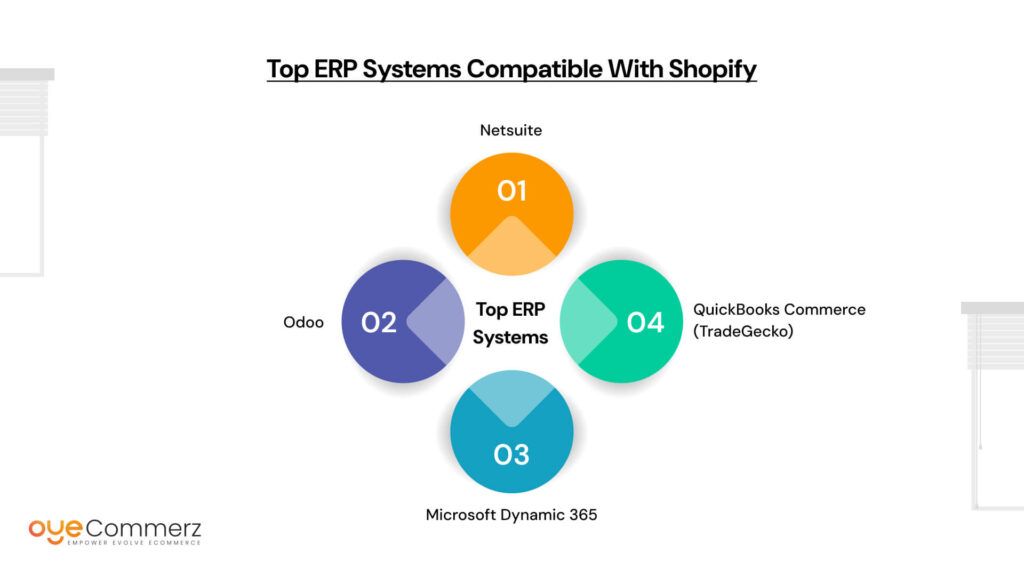
1. NetSuite
- Ideal for mid to large-sized businesses with complex operations
- Powerful for financials, inventory, and global commerce
- Offers native Shopify integration through apps and connectors
- Strong reporting and automation capabilities
2. Odoo
- Open-source and highly customizable
- Suitable for small to mid-sized businesses with in-house tech teams
- Modular system lets you add features like CRM, accounting, and inventory as needed
- More affordable, but may require custom integration with Shopify
3. Microsoft Dynamics 365
- Designed for enterprise-level businesses
- Deep functionality for manufacturing, supply chain, and customer engagement
- Tight integration with Microsoft ecosystem (Office, Power BI, Teams)
- Offers Shopify integration through third-party connectors
4. QuickBooks Commerce (TradeGecko)
- Great fit for small to medium-sized eCommerce brands
- Simplifies order, inventory, and supplier management
- Easy to set up with Shopify using built-in apps
- Affordable and user-friendly, though less scalable for large operations
How to Implement Shopify ERP Integration
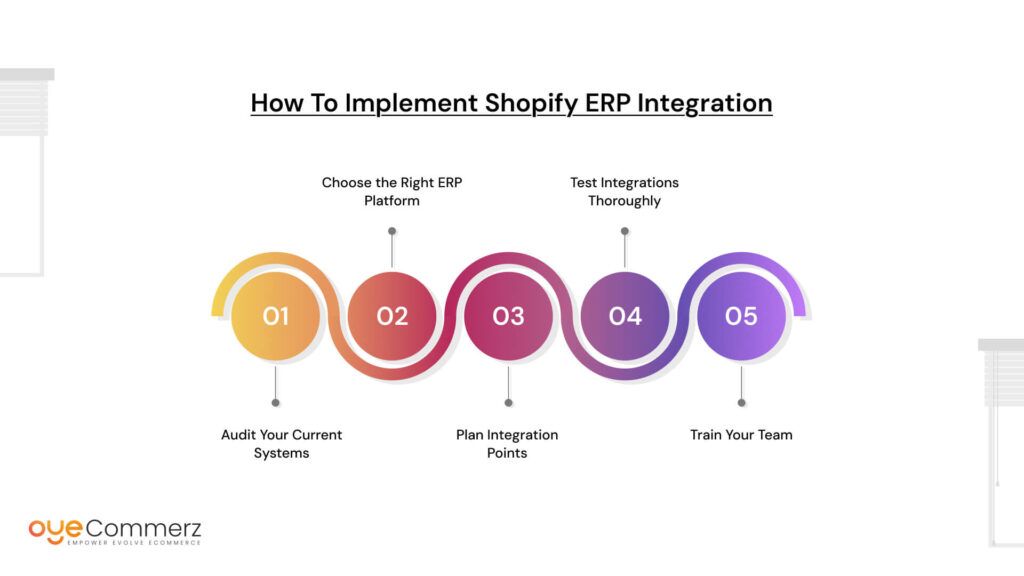
Successfully integrating your ERP with Shopify requires a clear strategy, technical know-how, and thorough preparation. Here’s a step-by-step breakdown of the process to ensure a smooth and efficient integration:
Step 1: Audit Your Current Systems
Start by evaluating your existing workflows, tools, and data. Identify:
- Current pain points (e.g., inventory mismatches, order delays)
- Data silos between departments
- Processes that would benefit most from automation
This step will help clarify your integration goals and ensure the ERP system addresses real business needs.
Step 2: Choose the Right ERP Platform
Based on your audit, select an ERP that aligns with your business size, industry, and future growth plans. Consider integration options, customization capabilities, and support resources.
Step 3: Plan Integration Points
Define which parts of your operations need to sync between Shopify and your ERP:
- Inventory management
- Order processing and fulfillment
- Customer data and CRM
- Shipping and logistics
- Accounting and reporting
Map out the data flow and determine how each system will communicate whether through APIs, middleware, or native apps.
Step 4: Test Integrations Thoroughly
Before going live:
- Run sandbox tests to check data accuracy and workflow consistency
- Simulate various order scenarios (e.g., cancellations, returns, stockouts)
- Validate that syncing works in real time without data loss or duplication
Step 5: Train Your Team
Provide hands-on training so your staff understands:
- New workflows and automated tasks
- How to use dashboards and reports
- Where to troubleshoot common sync issues
Smooth adoption by your team is crucial for long-term success.
Work with the Right Integration Partner
Shopify ERP integration can be complex, especially if custom workflows or multi-channel systems are involved. Collaborating with an experienced Shopify ERP integration partner ensures:
- Minimal downtime and disruption
- Clean data migration
- Ongoing support for scaling and optimization
Common Challenges and How to Overcome Them
While integrating Shopify with an ERP system delivers significant long-term benefits, the process does come with its share of challenges. Here’s how to anticipate and overcome the most common obstacles:
1. Data Sync Issues
The Challenge: Misaligned data between Shopify and the ERP can lead to inventory discrepancies, order errors, and customer frustration.
How to Overcome It:
- Conduct a data cleanup before integration to remove duplicates and inconsistencies.
- Use real-time sync where possible, and schedule regular data validation checks.
- Work with an integration partner that offers robust error-handling and support tools.
2. Cost of Implementation
The Challenge: ERP systems especially enterprise-grade ones can come with high setup and licensing costs, plus integration expenses.
How to Overcome It:
- Start with a clear ROI analysis, comparing cost vs. long-term time savings and efficiency gains.
- Explore modular ERP solutions like Odoo or QuickBooks Commerce for a phased rollout.
- Consider cloud-based ERPs with flexible pricing and lower infrastructure demands.
3. Change Management and Staff Training
The Challenge: Employees may struggle to adapt to new tools and processes, leading to reduced productivity during the transition.
How to Overcome It:
- Involve key stakeholders early to build buy-in and identify champions for change.
- Offer hands-on training, documentation, and Q&A sessions tailored to each team’s role.
- Allow time for adjustment and feedback, and maintain ongoing support during post-launch.
Ready to streamline your Shopify operations with powerful ERP integration?
Partner with Oyecommerz your trusted Shopify experts to implement the right ERP solution tailored to your business needs. From planning to execution, we handle the heavy lifting so you can focus on growth.
Contact us today to get started!
Let's build your custom Shopify app today!
Conclusion
Shopify ERP integration is a smart investment for businesses looking to scale efficiently. It brings real-time visibility, automates core processes, and eliminates manual work across inventory, orders, finance, and customer management. If you’re facing challenges with disconnected systems, rising order volumes, or expanding into new markets, integrating an ERP can streamline your operations and improve decision-making. For growing eCommerce brands, it’s not just worth it it’s essential for long-term success.
Frequently Asked Questions
Yes, Shopify can integrate with a wide range of ERP systems like NetSuite, Microsoft Dynamics, Odoo, SAP, and QuickBooks. This integration typically happens via APIs or middleware connectors, allowing real-time data syncing across inventory, orders, accounting, and customer management.
An integrated ERP solution centralizes data from different departments, automates repetitive tasks, and ensures real-time visibility across operations. It improves efficiency, reduces errors, enhances decision-making, and helps businesses scale faster by streamlining processes like inventory, accounting, and customer service.
Shopify offers a user-friendly platform for building and managing online stores. Key benefits include:
Easy setup and customization
Secure and reliable hosting
Built-in tools for payments, shipping, SEO, and analytics
Access to a large app ecosystem
Scalable plans for businesses of all sizes
The main benefit of implementing an ERP is centralized control over all business processes. It unifies departments like finance, inventory, HR, and sales into a single system, enabling better coordination, visibility, and decision-making.
Real-time data access and reporting
Improved inventory and supply chain management
Streamlined order and fulfillment processes
Automated financial and tax reporting
Better resource planning and operational efficiency



